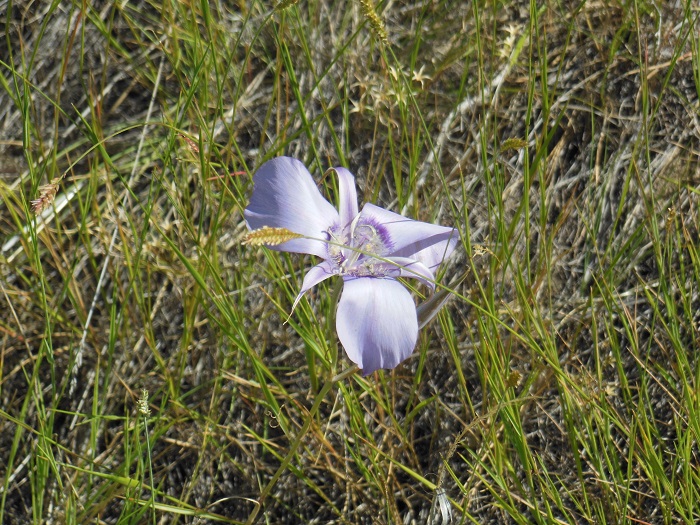It was my secret desire to find a Desert Night Snake, Canada’s rarest snake, that led me to visit the Desert Centre in Osoyoos, British Columbia, home of Canada’s only desert. That, plus my unexplainable fascination with the desert climate.
This region is also home to British Columbia’s longest snake, the Gopher Snake, its fastest snake, the Western Yellow-bellied Racer, and its most venomous snake, the Western Rattlesnake. Some of the visitors I toured with were anxious that they might actually see a rattlesnake during their walk, but the Western Rattlesnake is quite shy. In fact, there are only about three rattlesnake bites that occur in the entire province of British Columbia each year, and these usually occur because someone tried to harass the snake or pick it up. Sadly, I didn’t see any snakes on my tour.

The Osoyoos Desert Society is a non-profit organization that strives to conserve the endangered antelope-brush ecosystem in the South Okanagan. This area is one of the most endangered ecosystems in Canada, with one of the highest concentrations of at-risk species – 25 percent of the endangered and threatened species in the province are in this area. Only 30 percent of the original habitat remains and only four percent is conserved. To pay the fee to enter the Desert Centre is money well spent.

To enter the park, one must go through a small museum that highlights the conservation programs and the flora and fauna of the region. The trail itself is a 1.5-kilometer boardwalk designed to keep people from wandering directly into the fragile desert.

It was 9:30 am when I arrived and already quite hot. The hostess suggested I wait around for a half hour to participate in the guided tour. But I opted to first take the self-guided tour, and my reason for this was quite selfish – I wanted to enjoy the quiet of the desert alone. For me, I associate the barrenness of this climate with solitude. The stillness of the desert commands a certain level of quiet contemplation that I suspected would be disturbed by a group in a guided tour. And if I wanted to see some wildlife, particularly a snake, I thought a certain level of stealth might be required. I would catch up with the group later.

I found the walk to be just as quietly contemplative as I imagined. I saw Western bluebirds in my solo walk that we didn’t see when I was with the group. And I found the self-guided tour booklet and boardwalk displays to be quite informative, although our guide was able to fill in some blanks later.
There is much more to this landscape than initially meets the eye. It may look barren, but there are thousands of animals within shouting distance; they are either hiding or keeping cool underground or in the shade. The evidence of their presence is everywhere – bones left over from a coyote meal, deer and rabbit scat, tracks in the sand from a variety of animals.

I didn’t see a Great Basin Pocket Mouse, but the evidence was there in the holes leading down under the biotic crust, which is a very fragile thin crust that helps keep vegetation alive in the desert. Without it, the whole area would be sand dunes. The Pocket Mouse very rarely drinks; it has a very efficient system to ensure that it maximizes its use of water. It collects antelope-brush seeds and stores them in underground caches. These seeds collect the moisture from the pocket mouse’s breath and then the mouse eats the seeds, rehydrating itself.

The Burrowing Owl is now extirpated, meaning that it is locally extinct. The primary reason for this involves badgers, not because badgers eat the owls, but because badgers dig the holes in which the burrowing owls live. Burrowing owls don’t have the ability to dig their own holes. But the badgers are very rare in the area due to a diminishing wildlife corridor, so with very few holes in which to make its home and escape coyotes, the burrowing owl has vanished. The Desert Centre, along with the Burrowing Owl Winery and other volunteers, participates in a burrowing owl reintroduction program. On the tour, we could see where the Desert Centre has created an artificial burrow for the owls.

The Desert Centre also supports another at-risk species, the Great Basin Spadefoot. An artificial pond was created to replicate the spadefoot breeding ground. The pond is kept filled and monitored until the tadpoles have matured and left the water. The spadefoot is named as such because it literally has a digging tool attached to its leg in the shape of a spade. They use this spade feature to burrow into the loose sandy soil.

Once the tour group wandered back to the museum, I returned to the boardwalk for quiet observation. I still did not see any snakes on the desert floor, but I enjoyed the feeling of the sun on my shoulders and of my presence among the shy hidden creatures in this arid landscape.

—

—

—

